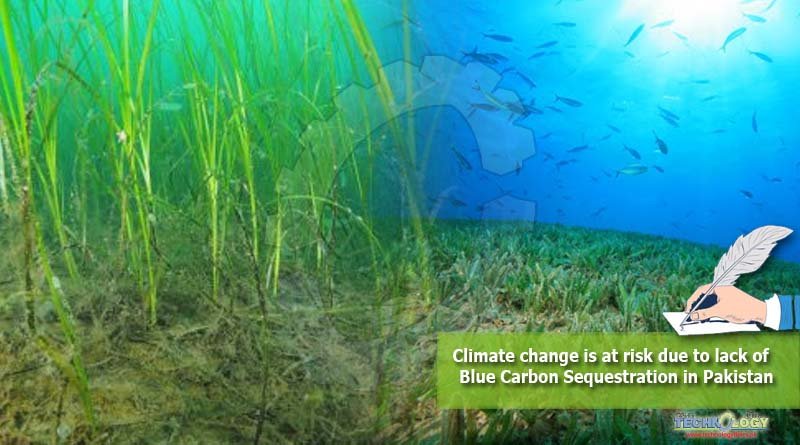Blue carbon sequestration is very important to control global warming, it absorbs carbon 40 times faster than terrestrial forests.
 Carbon is one of the most ample chemical elements present on Earth. It is universally abundant and essential component present in atmosphere, ocean and human body. It is also part of carbon mono oxide and carbon dioxide (a gas that comes from both natural and anthropogenic sources). Additional amounts of carbon dioxide discharged into the atmosphere is associated with climate change. It must be absorbed otherwise it becomes a great risk for environment. Forests and other terrestrial plants are good carbon absorbers but aquatic plants are greater and more efficient carbon sequesters than these terrestrial sources.
Carbon is one of the most ample chemical elements present on Earth. It is universally abundant and essential component present in atmosphere, ocean and human body. It is also part of carbon mono oxide and carbon dioxide (a gas that comes from both natural and anthropogenic sources). Additional amounts of carbon dioxide discharged into the atmosphere is associated with climate change. It must be absorbed otherwise it becomes a great risk for environment. Forests and other terrestrial plants are good carbon absorbers but aquatic plants are greater and more efficient carbon sequesters than these terrestrial sources.
Carbon sequestered by way of aquatic plant, coastal sediments and coastal ecosystems such as mangrove forests, sea grass meadows or inter tidal salt marshes is called blue carbon. These blue sequester components protect people from coastal erosion, storms and flooding; also making them valuable for climate change adaptation and provide nursery grounds for fish.
Terrestrial forests and plant biomass such as leaves, stems, branches or roots are pretty good at carbon sequestration, but their carbon stores are bound to the lifetime of the trees, for only 100 or so years, and then it is released back into the atmosphere, especially when it is cut down before maturity, blue carbon can be sequestered for years to decades, and for thousands to millions of years in underlying plant sediments.
Blue carbon sink components include mangroves, salt marshes and sea grasses, are found on every continent except Antarctica, cover less than 0.5% of the seabed. They are accountable for more than 50%, and possibly up to 70%, of all carbon storage in ocean deposits. These submerged seaside ecosystems cover between 13.8 and 15.2 million hectares (Mha), 2.2 and 40 Mha, and 17.7 and 60 Mha, respectively. Collective, these ecosystems cover approximately 49 Mha.
One of the main concerns with Blue Carbon is the rate of loss of these important marine ecosystems is much higher than any other ecosystem on the planet, even compared to rain-forests. Existing approximations recommend a damage of 2-7% per year that is not only lost carbon sequestration, but also misplaced habitation that is imperative for dealing environmental, coastline protection, and health benefits.
A mangrove is a shrub or small tree that grows in seaside saline or salty aquatic conditions. This term is also used for tropical seaside flora consisting of such kinds. Mangroves present worldwide in the tropics and subtropics areas. Mangroves are actuality lost at a degree of 2% per year. Professional’s evaluation about carbon emissions from mangrove deforestation account for up to 10% of emissions from deforestation universally, despite covering just 0.7% of land coverage.
Pakistan, blessed with more than 250000ha areas both in Sindh and Baluchistan regions. Mangrove swamps of the Sindh coastal zone are widespread, wrapping 243,000 hectares (ha) linked with 7,400 ha sideways with the Baluchistan coast.
A marsh is another blue carbon sink and is dominated by herbaceous rather than woody plant species. They can frequently present at the edges of lakes and streams, where they form a transition between the aquatic and terrestrial ecosystems. The three main types of marsh are freshwater marshes, salt marsh and fresh water tidally marsh. Carbon sequester rate in all three types is different. Marshes sequester carbon in underground biomass due to high rates of organic sedimentation and anaerobic-dominated decomposition.
Tidal marshes are being vanished at a frequency of 1-2% per year. They shield roughly 140 million hectares of Earth’s surface. They have vanished more than 50% of their historical universal coverage. Pakistan is blessed to have more than 240 major wetlands including 19 Ramsar sites, which are international significant wetlands, covering approximately an area of 1,343,627 hectares (3,320,170 acres) in Pakistan.
Seagrasses are a group of about 60 angiosperm species that have adapted to an aquatic life (here sponges, clams, small fish and other filter feeders thrive), and can grow in meadows sideways the beaches of all continents except Antarctica. They are essential for coral reef formations. Seagrass meadows habitats in maximum depths of up to 50m, depending on water excellence and light obtainability, and can include up to 12 diverse species in one meadow.
Sea-grasses are global deteriorating, with some 30,000 km2 (12,000 sq mi) lost during current decades. Sea-grasses are nearby 177,000 sq km left worldwide. Sea-grass meadows are badly affected by influences accruing from the billion or more individuals who live inside 50 km of them. Carbon sequestration rates in sea-grass meadows vary depending on the species.
For control of climatic change and reduction in carbon foot print, existence of blue carbon sinks are necessary but due to cutting of mangroves and plastic aquatic pollution these blue sinks are currently at great risk. Cleansing of coastal areas is also a great step for reduction in plastic pollution in aquatic habitats.
Keeping in mind the current scenario of such rapidly decreasing rate of blue carbon sinks, practical steps must be taken not only for survival of remaining aquatic plants but also for plantation of new plants and to safe their habitat because all these are complexity inter connected and important for climatic control.
